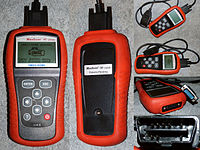On-board diagnostics

On-board diagnostics (OBD) are like a doctor's check-up for a car. Just like when you go to the doctor, they might use tools like a stethoscope to listen to your heart, or a thermometer to check your temperature, cars also have tools to diagnose what's going on inside them.
The OBD system in a car is like a bunch of sensors that check different parts of the car to make sure they're working okay. For example, it can check the engine, the fuel system, the brakes, the transmission, and many other parts.
The OBD system is connected to a little computer inside the car, which receives information from all the sensors. If something is not working right, the computer can show a message on the dashboard that tells the driver there's a problem. The message might be something like "Check Engine" or "Service Soon".
When a mechanic works on a car, they can also use a special tool to read the information from the OBD system. This tool can tell the mechanic what's wrong with the car and how to fix it.
So, basically, the OBD system is like a doctor for a car, making sure everything is healthy and working properly. If something is wrong, it can let the driver and mechanic know so that the problem can be fixed.
The OBD system in a car is like a bunch of sensors that check different parts of the car to make sure they're working okay. For example, it can check the engine, the fuel system, the brakes, the transmission, and many other parts.
The OBD system is connected to a little computer inside the car, which receives information from all the sensors. If something is not working right, the computer can show a message on the dashboard that tells the driver there's a problem. The message might be something like "Check Engine" or "Service Soon".
When a mechanic works on a car, they can also use a special tool to read the information from the OBD system. This tool can tell the mechanic what's wrong with the car and how to fix it.
So, basically, the OBD system is like a doctor for a car, making sure everything is healthy and working properly. If something is wrong, it can let the driver and mechanic know so that the problem can be fixed.
Related topics others have asked about:
